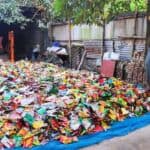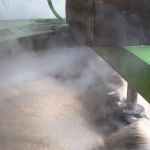Big Problem, Small Solution: Can Do-It-Yourself Processing Machines Help Combat Plastic Pollution?
From the video of a British diver swimming in a sea of plastic in Bali that went viral in March, to National Geographic’s major focus on the topic this year, there’s been a growing media spotlight on the problem of mismanaged plastic waste. Being based in Bali ourselves, Kopernik is close to the heart of the plastic problem: Indonesia is the largest economy in Southeast Asia, and also the second-largest contributor to global ocean plastic. In Bali, up to 110,000 tons of plastic waste are estimated to enter the waterways every year. As a social enterprise working to find practical solutions to today’s social and environmental challenges, the plastic crisis is a high priority for Kopernik – and we recently came across a solution that sounded promising.
Do-It-Yourself Plastic Recycling?
In 2016, at the height of the makerspace movement, Dutch engineer Dave Hakkens grabbed media attention with a seemingly simple idea – to make plastic recycling machines accessible to everyone. Hakkens is the founder of Precious Plastic, a global open-source platform that provides the tools and knowledge that can enable anyone to make their own plastic processing machines. As part of its mission to encourage plastic recycling worldwide, the movement has since reached at least 40,000 members around the world, from the United States to Brazil, South Africa and China.
Kopernik wanted to assess the effectiveness of Precious Plastic’s approach to addressing plastic pollution. To test the viability of these small-scale plastic processing machines, a team at Kopernik built a plastic injection machine based on a model by Precious Plastic. Our hypothesis was that the plastic injection machine would turn plastic waste such as bottle caps into products that could be sold at a profit, thus providing economic incentives for small businesses to collect plastic waste as a potential revenue-generating opportunity. After conducting a market assessment, building the machine, and analyzing all the costs, our experiment found that the machine could generate products that could be sold at prices three to ten times higher than the production costs. (More details on Kopernik’s Plastic Injection Machine experimentation project can be found here.)
Big Problem, (Too) Small Solution?
However, the size of the challenge raises doubts about the effectiveness of this approach. At its peak, the Bali government collects about 100 tons of rubbish along the beaches of Bali. Separately, a recent research study by Denpasar-based Udayana University and CSIRO, an Australian research agency, reported that plastic products made up 63 percent of the rubbish found on Bali’s beaches. With that assumption, it is estimated that approximately 63 tons of plastic trash is collected along Bali’s beaches per day. Of that, based on the research findings, we can assume that 32 percent are considered high value, which includes plastic bottles, containers, cups and lids.
Our experiment found that the Precious Plastic machine’s potential is limited by its production capacity, which is approximately 1.35 kg of high value plastic waste per day, putting into question the extent of its impact to address plastic pollution beyond the household level. Even if 100 of the plastic injection machines were built, they would be able to collectively process only approximately 135 kg of high value plastic waste per day – addressing only 0.7 percent of high value plastic waste, or 0.2 percent of overall plastic waste found along Bali’s main beaches.
“It is therefore unlikely that the small-scale DIY plastic processing machines can make a significant dent in the volume of mismanaged plastic waste,” said Nanis Sakti, Senior Analyst at Kopernik, who led the experiment. Still, Sakti noted that the technology is a valuable resource for waste-stricken communities, especially in remote areas that have yet to be reached by large-scale, government-funded waste management solutions. It can also serve as an educational tool to raise awareness of plastic recycling efforts.
Technology Empowers Communities
Kopernik’s findings mirror the ongoing discourse among stakeholders committed to combating global plastic pollution. Technology is undoubtedly an attractive solution, with projects such as the Ocean Cleanup and numerous plastics-to-fuel initiatives grabbing headlines. However, more research is needed to assess the extent of their impact, particularly when pitted against factors such as economies of scale and consumer behaviours.
Yet even if they’re not a silver bullet, these approaches can have value. Instead of being a standalone solution, small-scale tools such as the plastic injection machine can empower citizens with hands-on experience of plastic waste management practices. With slow progress towards a systemic solution, many communities – including those in Bali – have been taking matters into their own hands by organizing local waste management solutions and clean-ups. For instance, Padang Tegal village in Ubud, Bali manages its own waste management initiative focusing on separation at source. This is perhaps where technologies can potentially play an important role — in equipping communities to take charge of their local waste management initiatives.
In Sakti’s words: “The greatest value of these machines is the potential spill-over effect that can create a better understanding and appreciation of the importance of reducing and effectively managing plastic.”
Vanesha Manuturi is a Digital Content Officer at Kopernik.
Main photo from YouTube video. Small photo courtesy of Christian, via Flickr.
- Categories
- Environment, Impact Assessment, Social Enterprise, Technology



